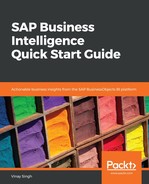For this exercise, we will use some sample eFashion Universe data, which is available at : https://wiki.scn.sap.com/wiki/display/BOBJ/eFashion+on+HANA.
Follow these steps to learn how to create a Lumira report based on Universe data:
- Launch SAP Lumira from your desktop.
- Create a new report in SAP Lumira. Choose File | New | Create a new dataset, as shown in the following screenshot:

- Choose SAP Universe Query Panel and then click Next:

- The system may prompt you to Update Extensions (depending on what you have chosen). I had the following prompt:

- Choose OK. After a few minutes, the extensions will have been updated, and you will get the following pop-up message, asking you to restart the Lumira client:

- After this has been restarted, you will be asked for your Universe credentials. Provide all the necessary details and click on Next:

You will be connected to the system and shown the available Universes that you can choose from.
- Choose the Universe called eFashion. Name the dataset Lumira Exercise with Universe, as follows:

- Add the following dimensions and measures to the results panel by dragging them from the navigation panel to the Result Objects for Query #1 panel: Year, State, City, Store name, Category, Lines, SKU number, Sales revenue, Quantity sold:

- Click on Finish.
- Once you have completed all of the preceding steps (the preparation phase), the following screen will appear (visualization).
- From here, we will create the report by putting Sales revenue on X Axis and Category on Y Axis. Choose Create from the MEASURES screen area and then drag Sales revenue onto X Axis and Categogy onto Y Axis, as follows:

- Change the orientation to horizontal. Use the Include option to filter for the category 2 Pocket shirts. You can do this by clicking the Horizontal Orientation button (as pointed to by the arrow in the following diagram). The measures and dimensions will appear across the top:

- Choose Include | 2 Pocket DE | Enter:

- Now, we can save it to our local computer, as follows:

- We have some new save options for the document (Local, Server for teams, and SAP BI Platform) when we try to save it. Choose the option that best suits your requirements:

- As we saw previously, you also have the option to Save without data. All of the documents that are created without this check box being checked means that the Lumira documents will contain no data until the time a user explicitly saves them. For instance, if we are modifying such a document on the SAP Lumira Server for BIP and choose Save, it would save the document with the data loaded when you opened the document. If you wish to save just your changes and not the data, then you should click on Save without data.
- Now, let's try to create a new report. This time, we will use a hierarchy. The steps for connecting to the eFashion dataset remain the same.
- We add the same dimensions and measures to the results panel, that is, Year, Store name, Category, Lines, SKU number, Sales revenue, and Quantity sold:

- Filter the data in the query so that we have optimal performance for the year 2004. Create the report with Sales revenue on the X Axis and Category on the Y Axis:

- Now, we will create a custom hierarchy with Lines, Category, and SKU number as levels. In the dimensions screen area, hover over SKU number and choose the Options icon. Choose Create a custom hierarchy, as follows:

- In the Create Hierarchy dialog box, add Lines, Category, and SKU number in that order. Enter a name for the hierarchy named Hierarchy and click on Create:

- Create a pie chart visualization with SKU_Hierarchy and Sales revenue. Alternatively, you can use a different representation to visualize the data. Then, save it, like we did earlier.
